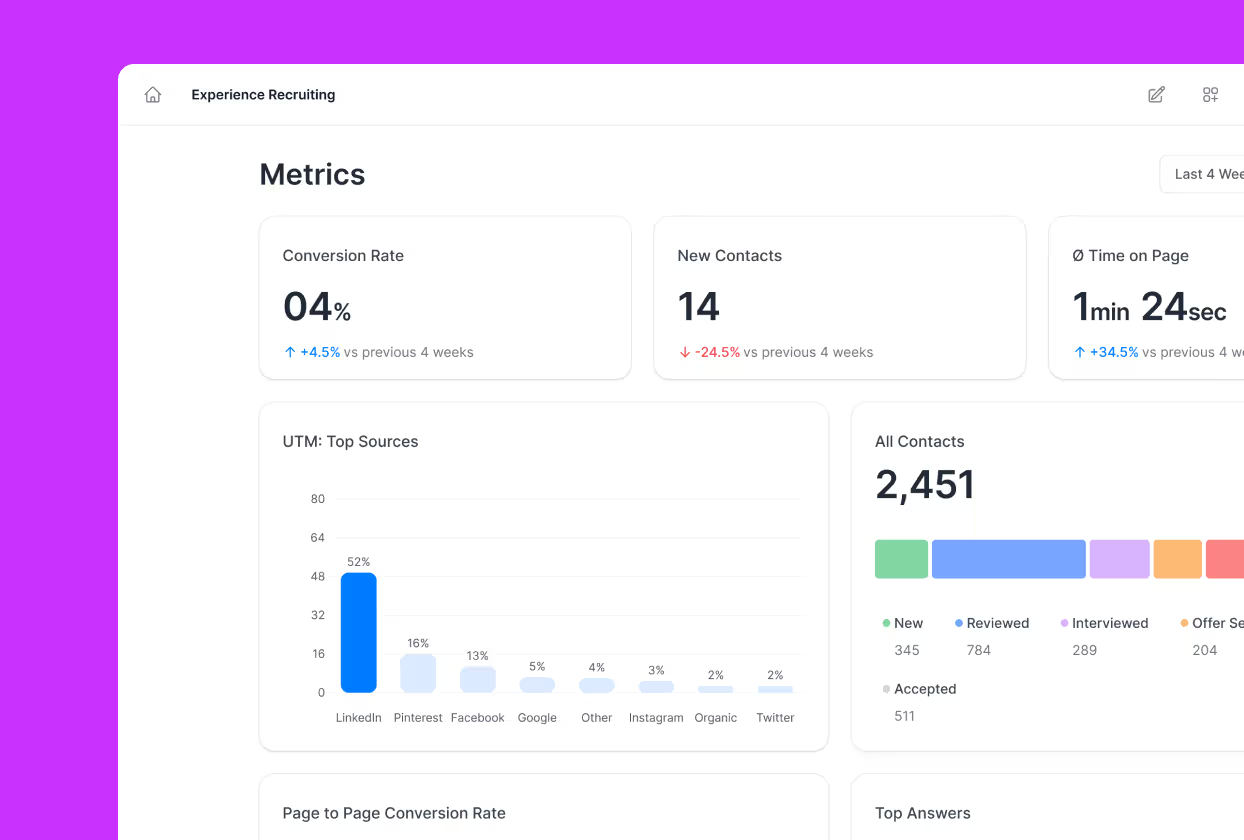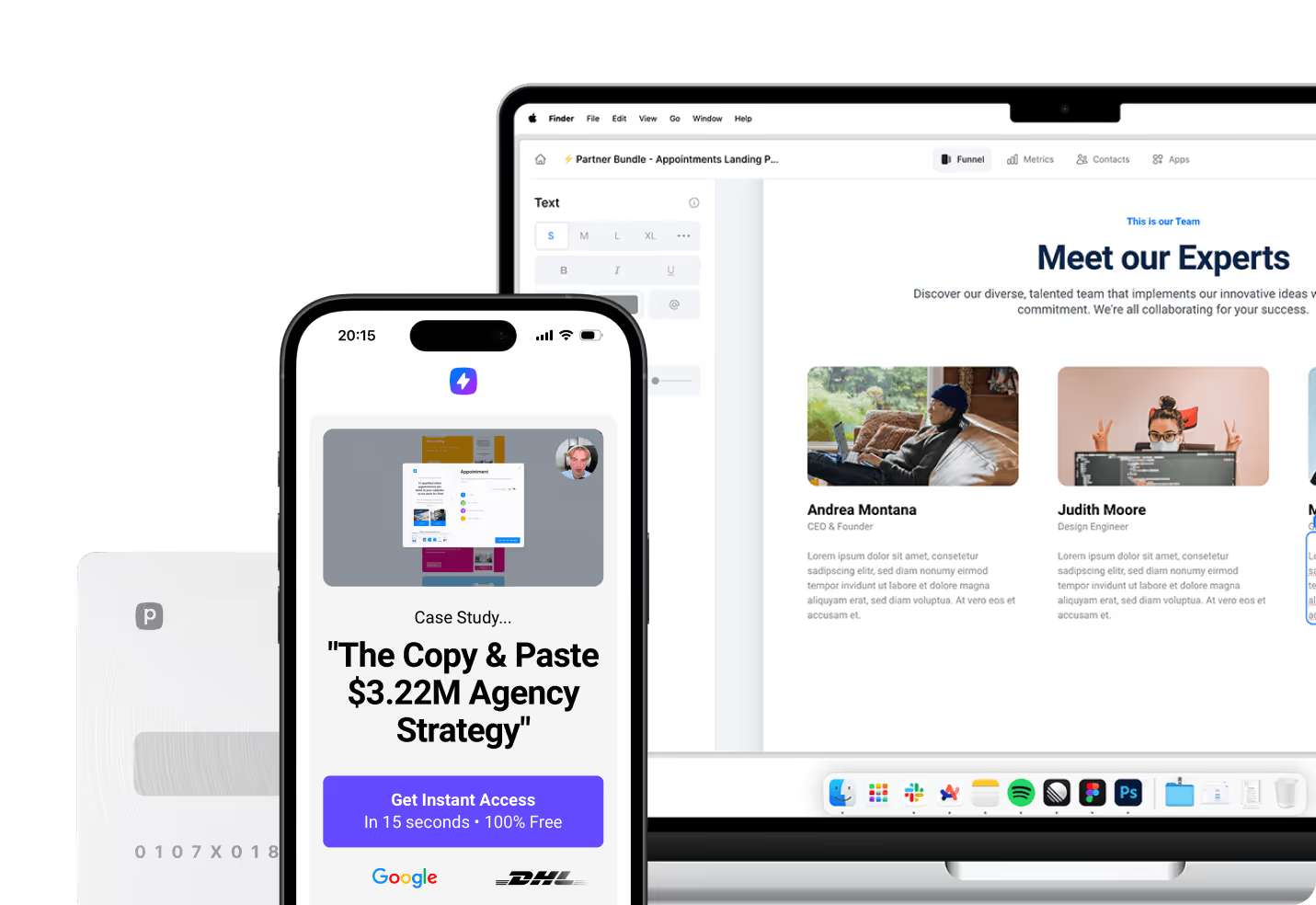
Unbounce is an established landing page builder, used by marketers and agencies to create conversion-focused pages. But over time, many teams start asking: are there any Unbounce alternatives that are a better fit?
When costs rise, mobile layouts require extra work, or integrations stack up, marketers look for Unbounce competitors that can improve conversions.
In this guide, we’ll compare the best Unbounce alternatives so you can find the right solution for your business.
Let’s explore the top alternatives to Unbounce 👇
Summary
This Unbounce alternatives snapshot highlights the best tools and what sets each one apart.
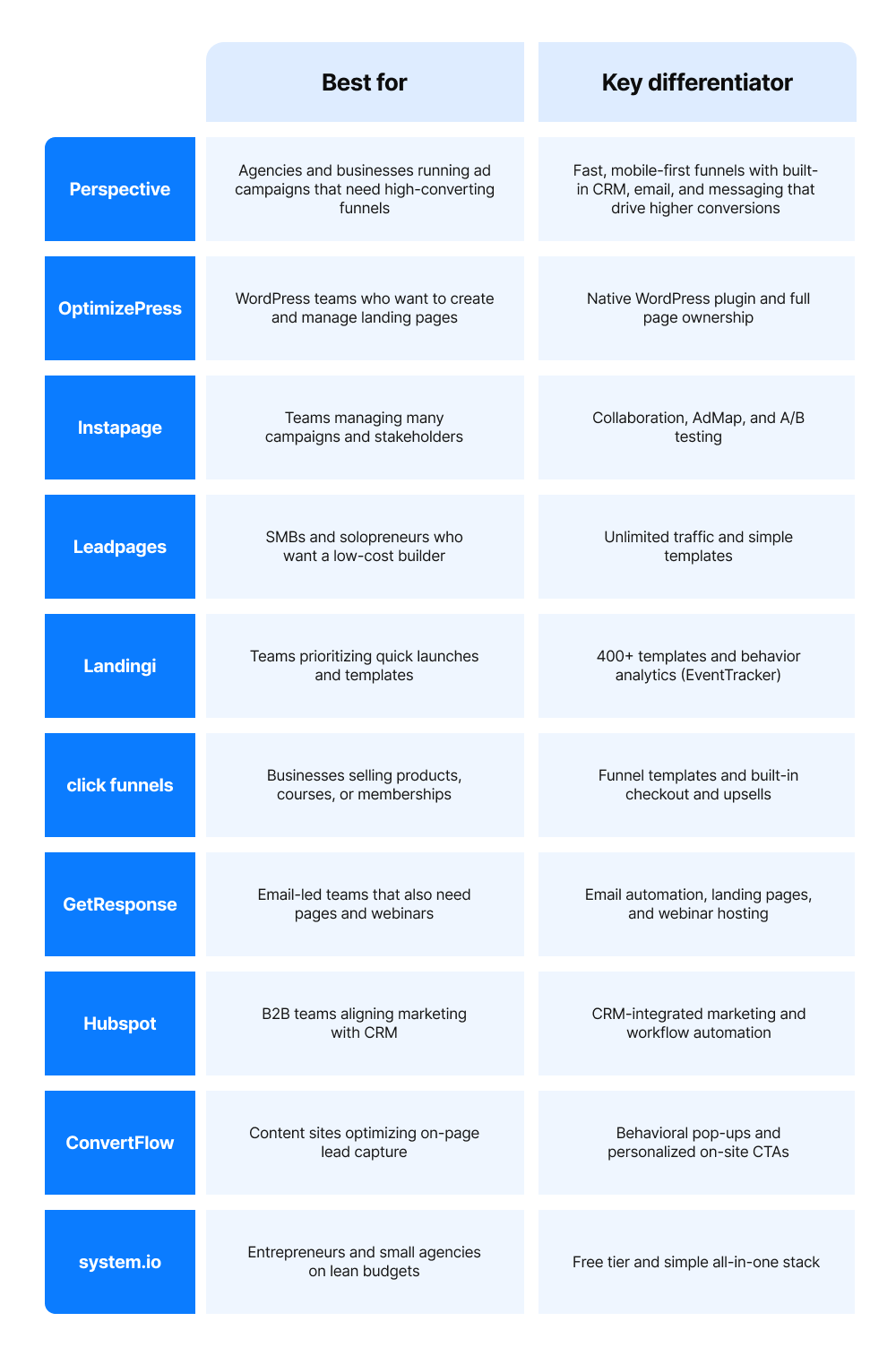
These Unbounce alternatives were chosen based on what actually moves the needle:
- Mobile performance: Speed and usability on mobile devices.
- Conversion capability: Built-in CRM, email, and messaging depth.
- Pricing clarity: Predictable, transparent plans.
- Testing and analytics: Native A/B testing and reporting tools.
- Ease of use: Speed to launch and collaboration features.
They’re what distinguish tools that sound good from those that deliver real results.
Let’s explore each option in detail 👇
1. Perspective
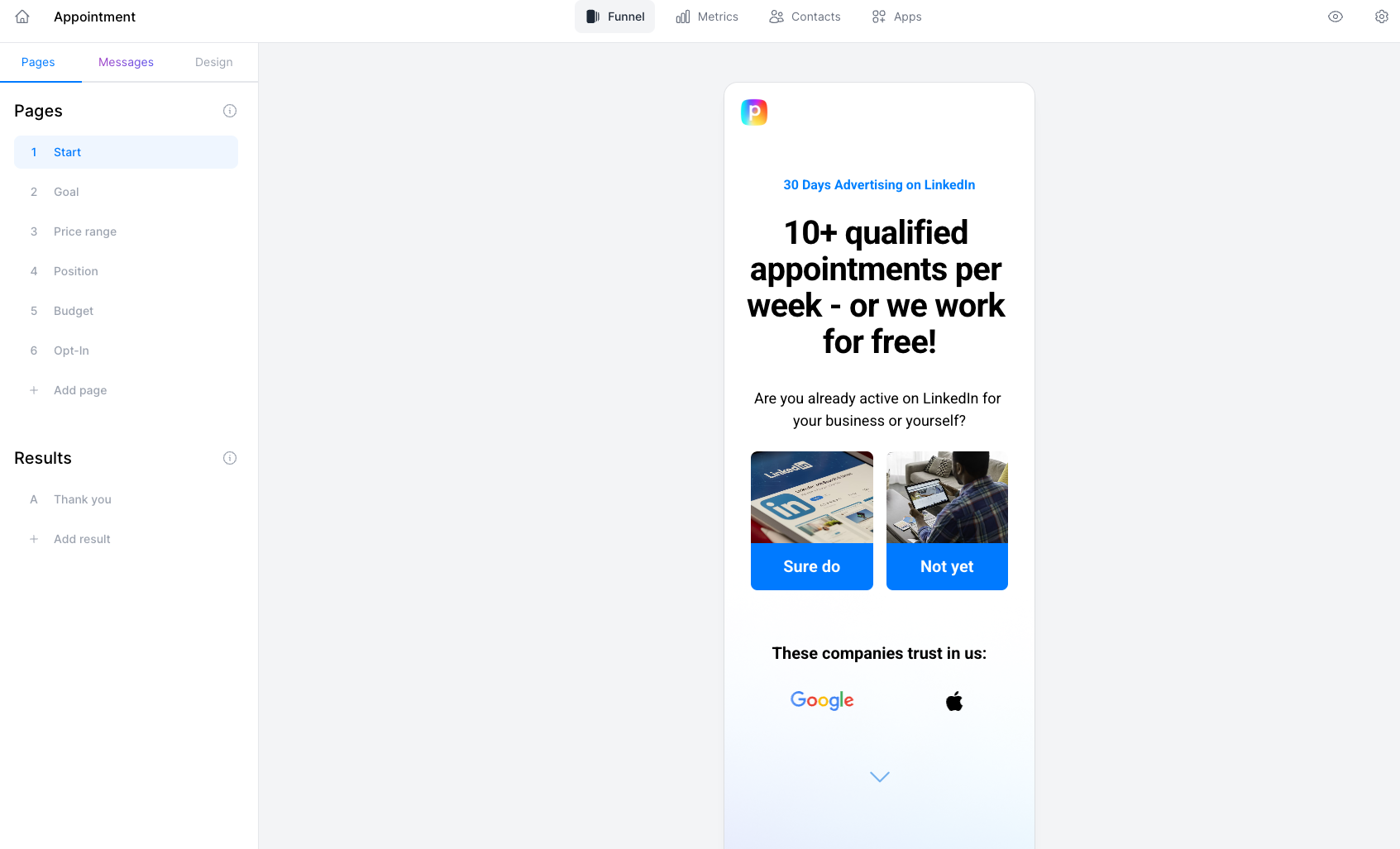
Best for agencies and marketers that want higher conversions without complexity.
Perspective is the strongest overall alternative to Unbounce. It combines fast setup, simple campaign management, a capable CRM, native email and messaging, and built-in analytics into one package. This makes it both easy to use and predictable to scale.
And because it was designed natively for mobile, funnels load in under three seconds, ad traffic converts at a higher rate, and teams see stronger ROAS. The mobile foundation is a clear edge, but it’s only part of why Perspective outperforms.
Use case example: Performance marketing agencies use Perspective to launch funnels that consistently outperform generic landing pages or instant forms.
Instead of pushing traffic to slow websites, they spin up swipe-friendly funnels that match visitor intent, qualify leads with quizzes, and convert more of the right visitors.
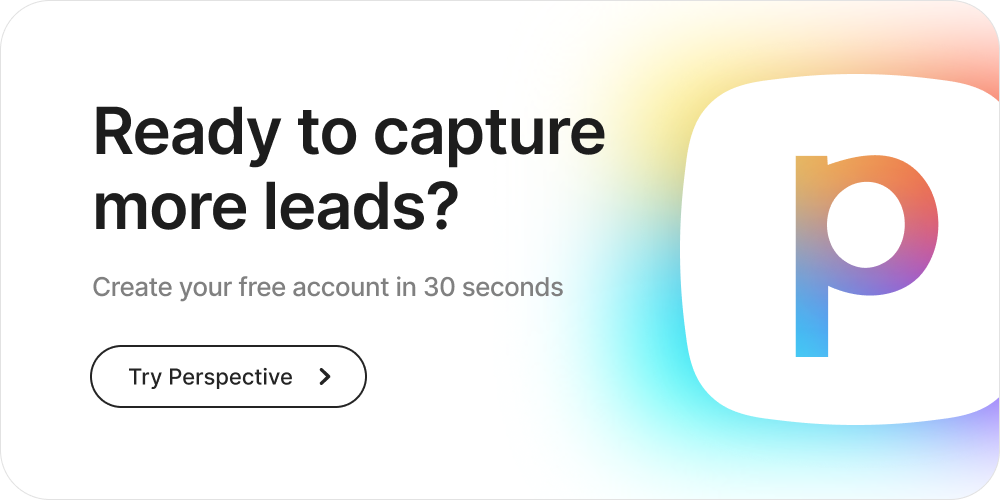
Key features:
- Lightning-fast speeds, funnels load in under 3 seconds.
- Built-in CRM with lead statuses, notes, and profiles.
- Native email and messaging for automated follow-up.
- Personalisation at scale with dynamic fields like names, paths, and offers.
- Built-in analytics to track conversions without extra tools.
Pricing:
Perspective offers transparent, license-based pricing without hidden fees or usage caps. Higher tiers raise limits (live funnels, workspaces, domains) and add A/B testing, white label, personalization, premium integrations, and enhanced support.
Annual plans are $63 per month for the Start tier, $197 for Grow, and $397 for Expand. The Scale tier is available on custom terms. This model ensures predictable costs, unlike traffic-based pricing, which can increase as campaigns scale. The Start, Grow, and Expand tiers all include free trials.
Reviews:

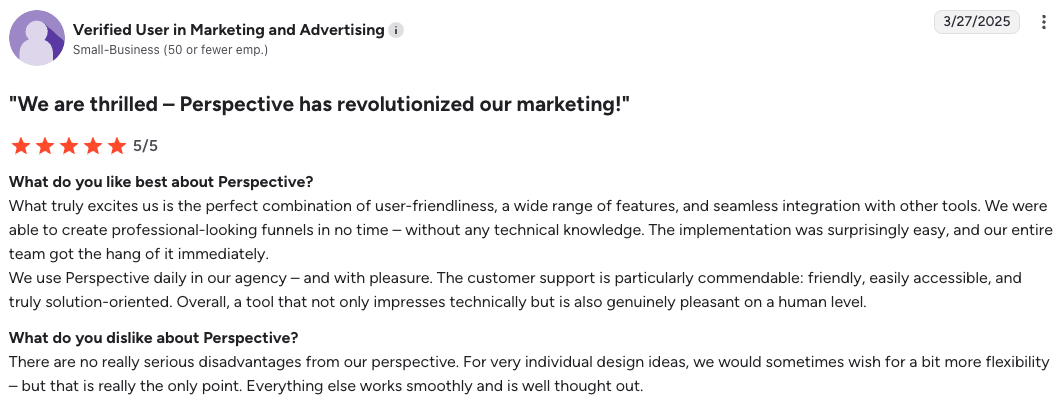
Source: G2
Perspective vs Unbounce: who to choose?
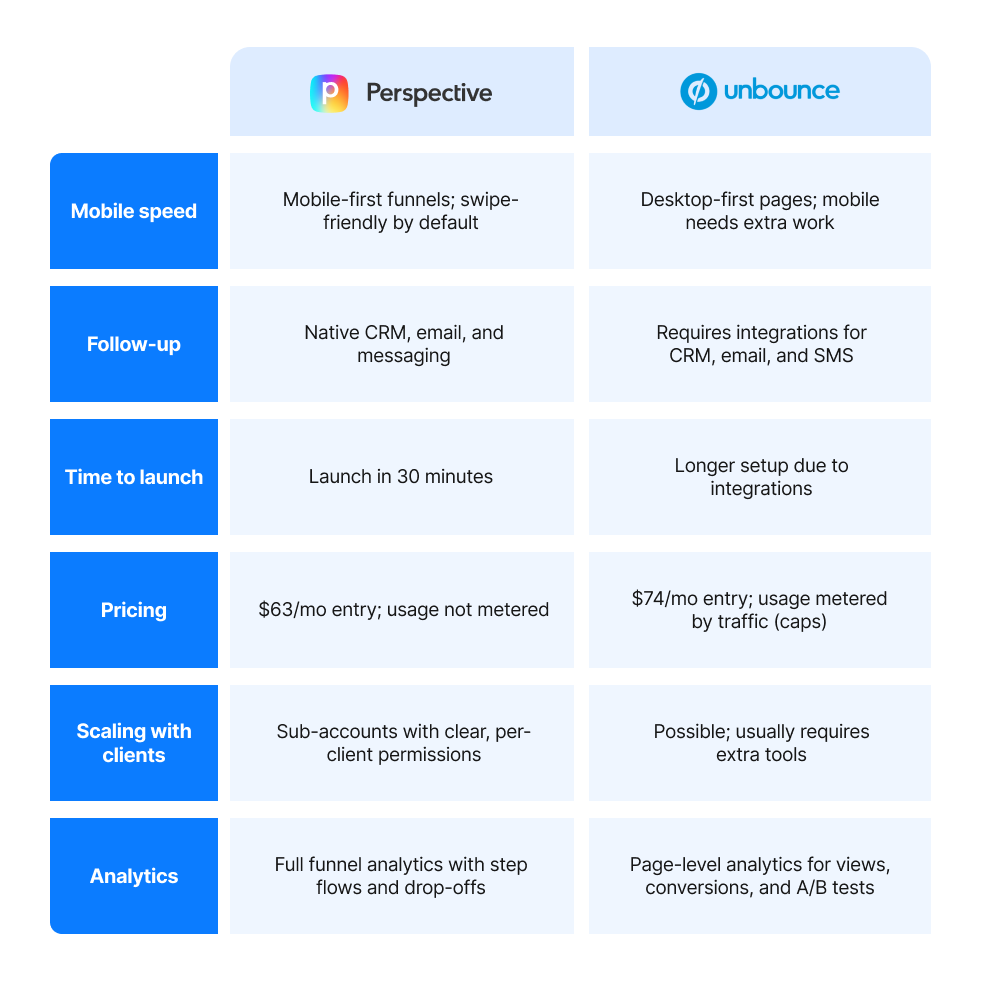
Perspective is best if you need to launch fast, mobile-ready funnels that scale.
No bolt-on email, SMS, or CRM — and no page-only setup like Unbounce.

2. OptimizePress
Best for teams who live in WordPress and want ownership and templates.
OptimizePress is a WordPress plugin suite that lets users create landing pages, funnels, and memberships directly inside their existing environment. It removes the need for external hosting or integrations by running within your existing site stack.
As an Unbounce alternative, its main differentiator is control and ownership. WordPress users can keep their current site structure while adding conversion-optimized pages and funnel features. The trade-off is that you’re limited by your hosting performance, and setup depends on WordPress familiarity.
Use case example: A small agency already using WordPress can add landing pages and sales funnels on its existing host using a plugin, without a separate hosted platform.
Key features:
- Conversion-optimized templates
- Drag-and-drop funnel builder and checkout tools
- Countdown timers, pop-ups, and A/B testing
- WordPress-native integration and plugin flexibility
Pricing:
OptimizePress uses annual, license-based pricing for self-hosted WordPress sites, with no page or traffic caps. Plans are billed annually: Starter is $99 for the first year (renews at $129), Plus is $149 (renews at $199), and Ultimate is $179 (renews at $249). Plus adds Funnels and Checkouts for selling products/subscriptions across multiple sites; Ultimate adds courses/memberships and higher site limits.
Reviews:


3. Instapage
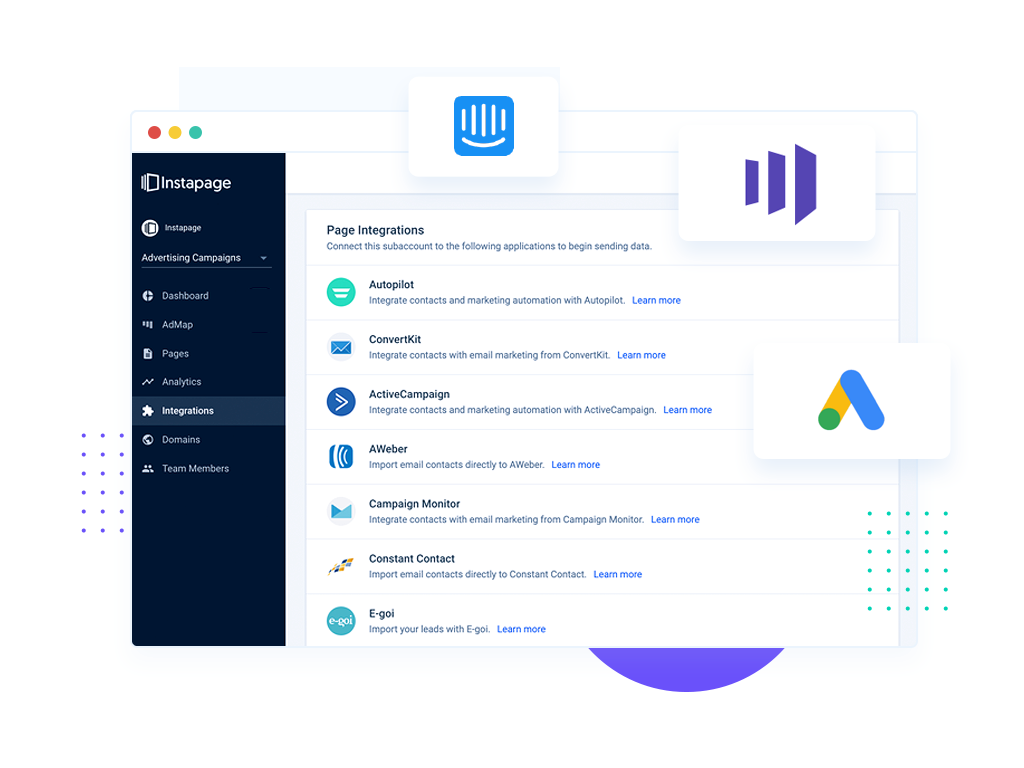
Best for large teams that need real-time collaboration and structured testing.
Instapage is a landing page platform designed for enterprise teams that value collaboration and personalization. Its interface enables editing, commenting, and page sharing across departments.
Features include AdMap™ (mapping ad campaigns to landing pages) and an analytics suite. However, these are only available on higher-priced tiers.
Use case example: A multi-person marketing team uses Instapage to collaborate on landing pages, run tests, and speed up approvals across campaigns.
Key features:
- AdMap™ for ad-to-page alignment
- Heatmaps and server-side A/B testing
- Real-time commenting and review links
- Conversion-focused templates
Pricing:
Instapage has a monthly, tiered pricing model. Create is $79/month (billed annually) for up to 15,000 unique monthly visitors. Optimize is $159/month (billed annually) for 30,000 visitors, with higher-traffic options (50,000 or custom). Convert is custom-priced for enterprise needs.
All plans include unlimited pages, conversions, and contacts; higher tiers add server-side A/B testing, traffic splitting, heatmaps, and more.
Reviews:


Source: G2
4. Leadpages
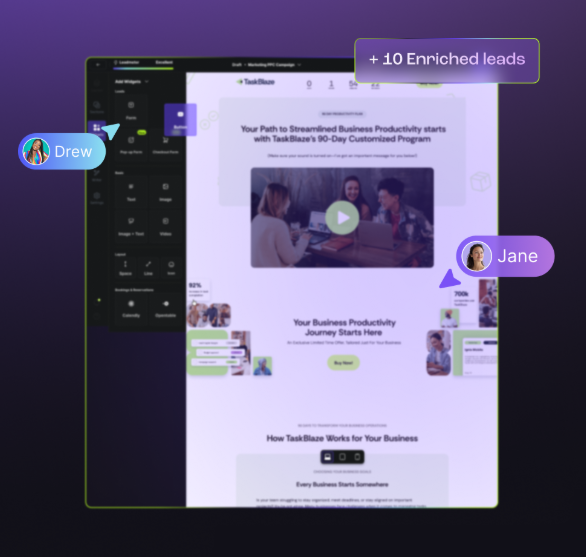
Best for SMBs and solopreneurs looking for an affordable landing page builder.
Leadpages includes a drag-and-drop editor, built-in templates, and AI content assistance. It’s designed to make design and conversion testing accessible to small teams.
Leadpages has transparent pricing and an unlimited traffic policy. You can scale campaigns without usage caps. When you compare Leadpages with Unbounce alternatives, its downsides are limited design flexibility and form customization, as well as basic analytics.
Use case example: A solo marketer creates multiple campaigns each month without worrying about visitor limits.
Key features:
- Drag-and-drop editor and AI copywriter
- Unlimited traffic and leads on all plans
- Built-in conversion tips via Leadmeter
- Pop-ups, alert bars, and form management
Pricing:
Leadpages has two published pricing tiers. Standard is $37 per month (billed annually) with 5 landing pages and 1 custom domain. Pro is $74 per month (billed annually) with unlimited landing pages and up to 3 custom domains. There is a custom plan for those with more complex needs. Add-ons are available for lead enrichment and adding users.
Reviews:
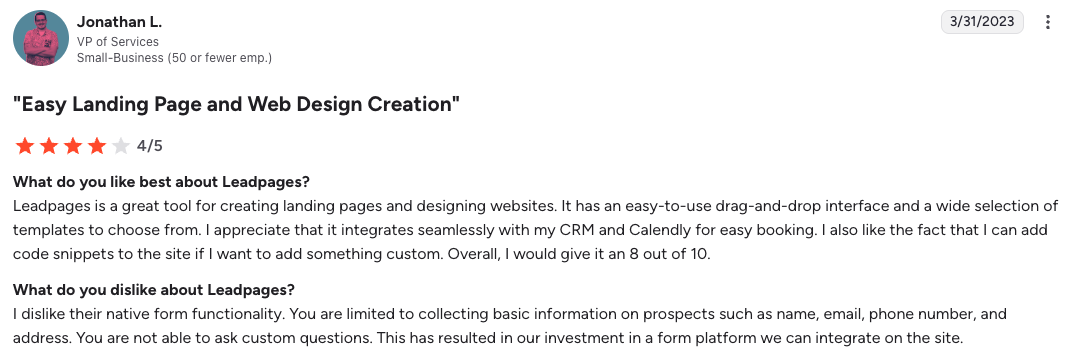

Source: G2
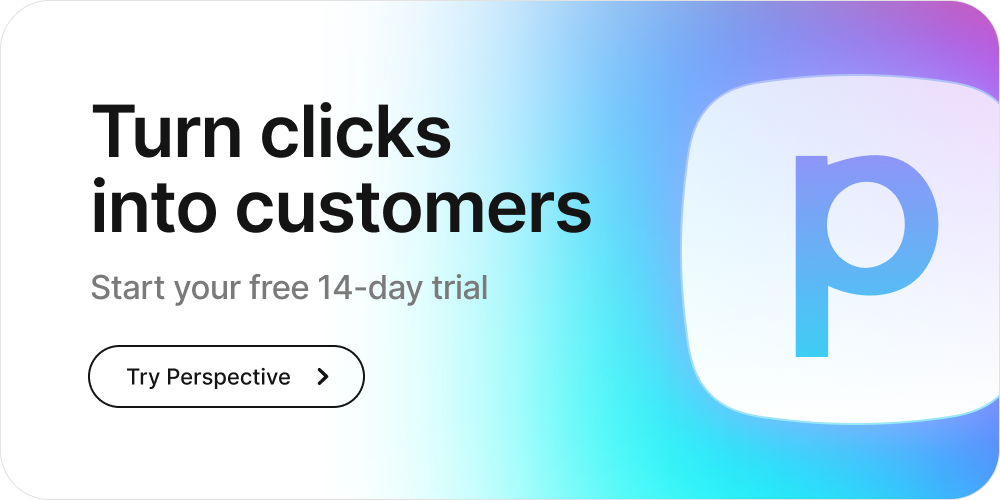
5. Landingi
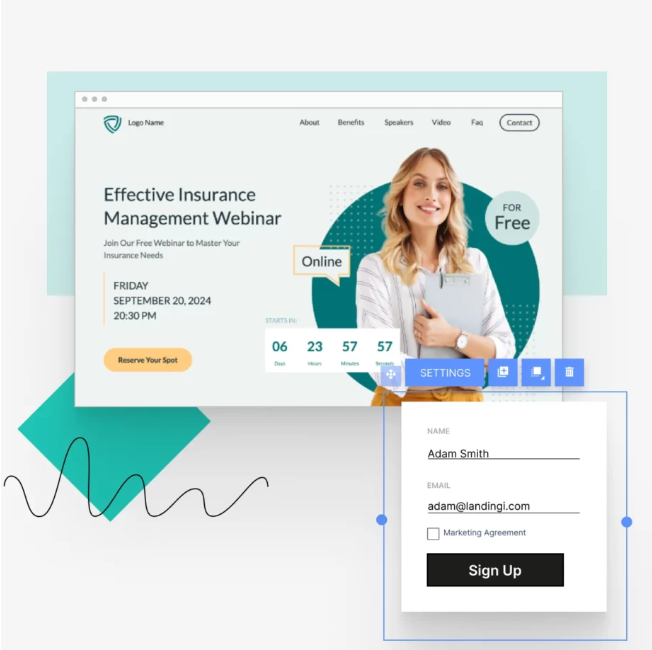
Best for teams that value template variety and straightforward analytics.
Landingi is a landing page and funnel builder that emphasizes design flexibility and ease of use. It offers a broad template library and integrates with a wide range of marketing tools.
Landingi focuses on usability and insight through its EventTracker feature, which provides behavior analytics. The trade-off: its reporting and testing tools are simpler than other Unbounce alternatives.
Use case example: A small marketing agency uses Landingi to quickly spin up campaign-specific pages and analyze engagement through EventTracker.
Key features:
- Customizable templates
- Smart Sections for bulk editing
- EventTracker for micro-conversion tracking
- Integrations with a wide range of marketing tools
Pricing:
Landingi offers four pricing tiers. There is a limited free tier available, and annual plans start at $27 per month for Lite (10 active pages, 1 domain, 5,000 monthly visits). Professional ($65) raises this to unlimited pages, 10 domains, and 50,000 visits. Enterprise is custom-priced with higher limits and admin controls.
Reviews:
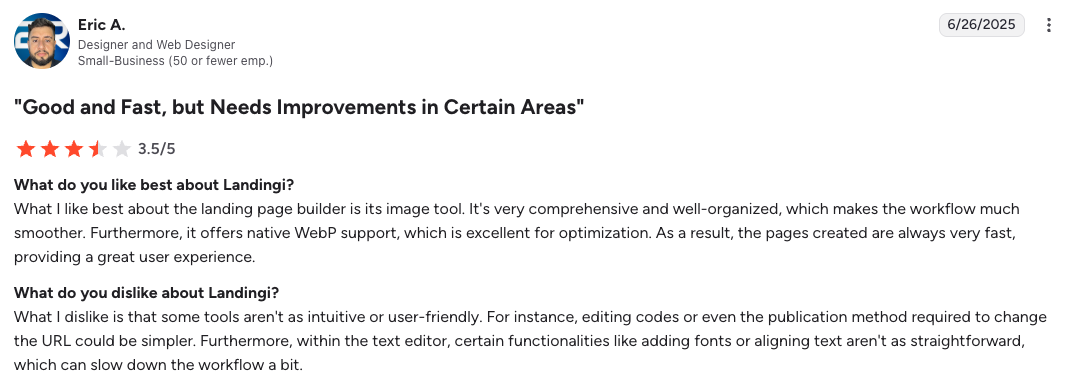

Source: G2
6. ClickFunnels
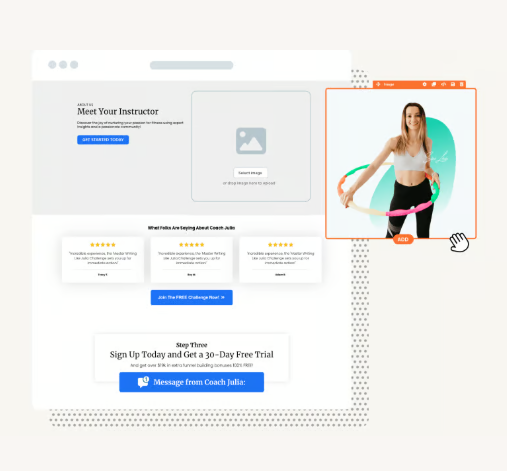
Best for entrepreneurs and small businesses that want prebuilt funnels and upsells.
ClickFunnels is a funnel builder for landing pages, checkout, and memberships. It includes pre-built templates and an active user community.
ClickFunnels delivers a broad toolkit for monetization, including courses, eCommerce, and memberships. However, it’s more expensive and has a steeper learning curve than most Unbounce alternatives.
Use case example: A course seller uses ClickFunnels templates to set up a basic funnel with checkout and recurring billing in one tool.
Key features:
- Funnel visualization and step analytics
- Templates for courses, products, and events
- Integrated payments and memberships
- Automated email workflows
Pricing:
ClickFunnels has four different plans available. Launch is $81 per month (billed annually) and covers one workspace. Scale is $164 per month and includes more users and workspaces. Optimize is $248 per month, and it includes 10 workspaces and team members.
The Dominate plan is the highest tier, with 20 workspaces and team members. It costs $5,997 per year (annual billing only). A free trial is available for Launch, Scale, and Optimize.
Reviews:


Source: G2
{{cta}}
7. GetResponse

Best for Marketers who prioritize email marketing and automation.
GetResponse is an all-in-one marketing suite offering email, automation, and webinars alongside landing pages. It’s suited to teams that rely heavily on email nurturing, a unique characteristic among Unbounce alternatives.
GetResponse prioritizes email marketing, but its landing-page design abilities are quite basic. It’s affordable and beginner-friendly, but it isn’t a specialized landing page tool.
Use case example: An eCommerce store uses GetResponse to build product-specific landing pages that trigger automated email sequences for abandoned carts.
Key features:
- Email marketing and automation builder
- Webinar hosting and audience segmentation
- Drag-and-drop landing page creator
- Conversion analytics and CRM integration
Reviews:


Source: G2
8. HubSpot Marketing Hub
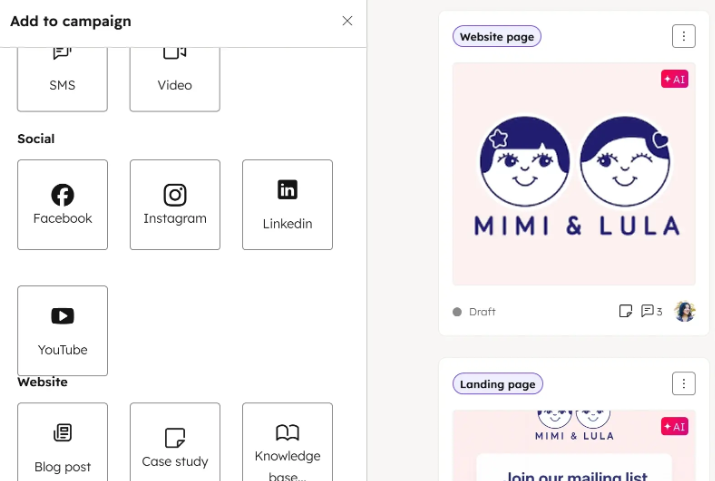
Best for mid-market and enterprise teams needing full CRM integration.
HubSpot Marketing Hub extends its CRM ecosystem into landing page creation, enabling connected customer journeys. Every page interaction ties into your CRM and workflows.
HubSpot provides good data integration and personalization. However, costs scale steeply compared with Unbounce alternatives, making it excessive for smaller teams.
Use case example: A B2B company uses HubSpot to generate leads and automatically route them into sales pipelines while triggering tailored email nurturing.
Key features:
- Drag-and-drop page builder within HubSpot CRM
- Dynamic content personalization
- Analytics dashboards and workflow triggers
- Deep integration with sales + service hubs
Pricing:
HubSpot presents Marketing Hub in two tracks. For individuals and small teams, there’s a free plan (up to two users), and other tiers include a Starter plan with 1,000 marketing contacts; current pricing is $12 per seat per month (annual billing).
For businesses and enterprises, pricing is packaged with seats and contacts included: Professional starts at $941 per month (annual billing) with 3 Core Seats and 2,000 contacts and requires $3,485 onboarding; Enterprise starts at $4,021 per month with 5 Core Seats and 10,000 contacts and $8,162 onboarding.


Source: G2

9. ConvertFlow
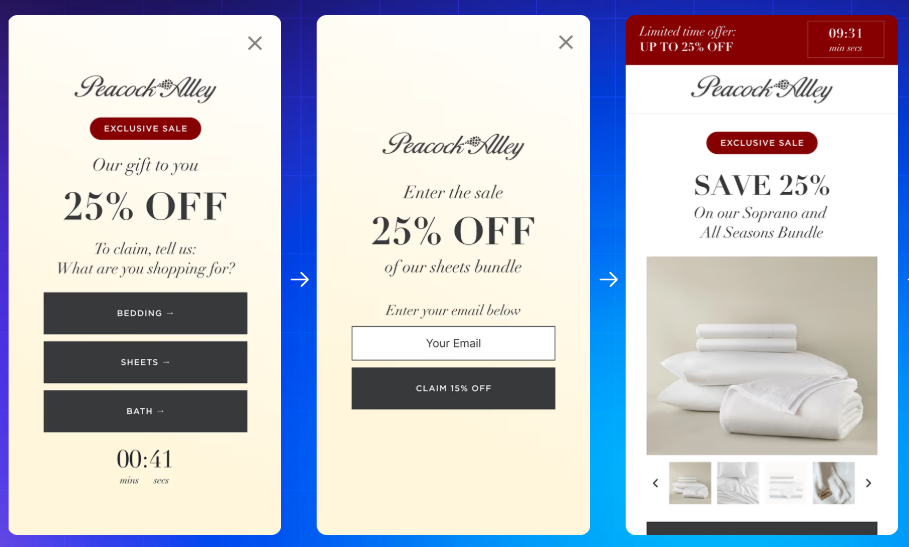
Best for marketing teams with content-rich sites, who want to increase on-site engagement.
ConvertFlow provides various conversion elements, including landing pages, forms, sticky bars, pop-ups, and quizzes, all of which adjust based on visitor behavior. It’s built for teams running large content or blog sites.
It works well for content-heavy sites, but compared with other Unbounce alternatives it offers less precise control over page design and simpler testing/analytics. This means advanced experiments may need separate tools.
Use case example: A SaaS blog uses ConvertFlow to display tailored pop-ups and forms depending on user scroll depth or page category.
Key features:
- Pop-ups, quizzes, and embedded forms
- Behavioral targeting and segmentation
- Workflow triggers via CRM integration
- Conversion analytics across site elements
Pricing:
ConvertFlow uses traffic-based tiers measured by monthly funnel views, with monthly or annual billing (annual gives two months free). There’s a free tier for building/previewing; publishing requires an upgrade.
Pro is $250 per month for up to 30,000 views, Plus is $500 per month for up to 100,000 views, and Custom starts at $999+ per month for 250,000+ views.
Reviews:


Source: G2
10. Systeme.io
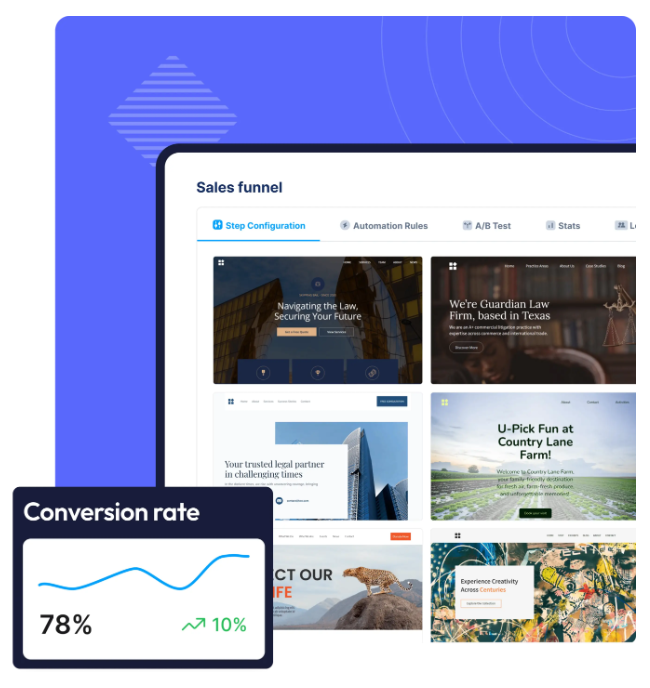
Best for entrepreneurs and small agencies seeking an all-in-one platform on a budget.
Systeme.io combines funnel building, email marketing, memberships, and automation in one tool. It offers a free plan with usage limits, and paid tiers expand capacity and features. The emphasis is on simplicity and low cost rather than deep customization.
Systeme.io eliminates the need for multiple subscriptions, though users will hit limits faster on design and scalability compared to other Unbounce alternatives.
Use case example: A solo entrepreneur sets up a basic course funnel and email series on the free plan, upgrading to a paid tier when they need more contacts.
Key features:
- Free plan for up to 2,000 contacts
- Funnels, email automation, courses, and memberships
- Affiliate program management
- 1-click upsells and order bumps
Pricing:
Free plan available. Paid tiers start at $17 per month for 5,000 contacts, scaling to $97 for unlimited contacts and expanded features.
Reviews:

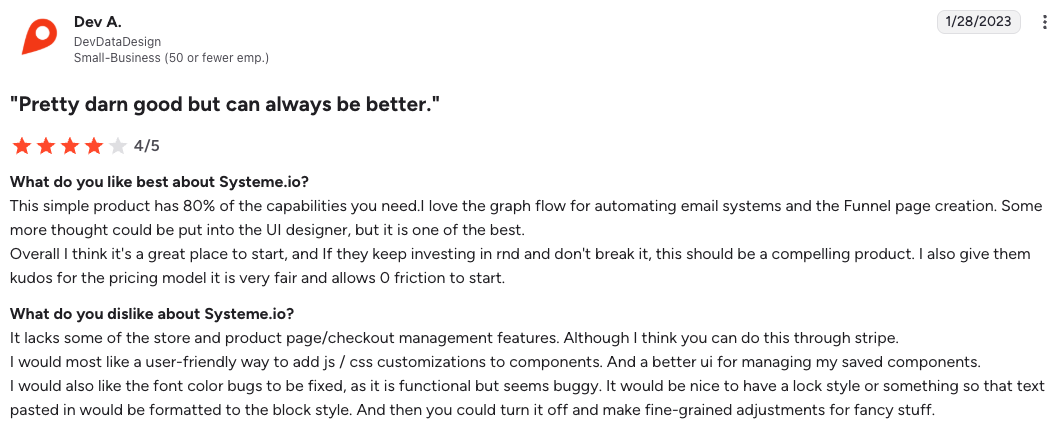
Source: G2
FAQs: Unbounce Alternatives
What’s better than Unbounce?
Perspective is better than Unbounce. Unbounce is a solid page builder, but most teams end up bolting on email/SMS, CRM, and automation — adding cost and complexity. Perspective is mobile-first, includes native email and messaging, and ships complete funnels faster with fewer moving parts.
If you care about speed, conversions, and simpler ops, Perspective is the strongest unbounce alternative 👉 Start your 14-day free trial
Which landing page builder is best?
Perspective is the best landing page builder. It delivers mobile-optimized funnels out of the box, with built-in follow-up (email/messaging) and predictable pricing.
By comparison: Instapage excels at collaboration but relies on add-ons for comms; Leadpages/Landingi are cheaper but lighter for testing/scale; OptimizePress ties you to WordPress; Systeme.io is all-in-one but constrained as campaigns grow.
What are the cons of Unbounce?
The cons of Unbounce are: you'll likely rely on integrations for lifecycle comms (email/SMS, CRM), site-wide personalization typically requires extra tools, and pricing escalates as you scale.
That’s why many teams evaluate Unbounce alternatives that include funnels and follow-up.
Is Unbounce worth it?
Unbounce can be worth it for teams that want a standalone page builder and don’t mind adding separate tools for email, SMS, and CRM.
If you’d rather ship faster with mobile-first funnels and native follow-up, you’ll find a stronger fit with Perspective.
How is Optimizely different from Unbounce?
Optimizely is different from Unbounce because it is an experimentation platform for websites and apps with feature flags. It doesn’t build pages. Unbounce is a landing page builder with page-level testing.
If you need mobile-first funnels with built-in follow-up (email and messaging) and full funnel capabilities, Perspective is the best choice.
Is there a cheaper Unbounce competitor?
Perspective is a cheaper Unbounce competitor. It starts at $63 per month and includes native email and messaging, so you’re not stacking extra vendors to run follow-ups. That keeps total cost and maintenance lower as you scale.
I’m on WordPress — what fits?
OptimizePress fits if you want to stay 100% WP-native. If speed on mobile and integrated comms matter, keep WordPress for content and run acquisition funnels in Perspective.
The Unbounce alternative built for higher conversions
If you’re looking for an Unbounce alternative that gives you:
✔️ Funnels built in 30 minutes with drag-and-drop simplicity.
✔️ Mobile-first design that loads in under 3 seconds.
✔️ Better ROAS from ads driving to mobile-optimised pages.
✔️ Built-in CRM, native email and messaging, plus analytics — without the heavy overhead.
✔️ Personalisation at scale so every lead feels unique.
✔️ Lower entry price than Unbounce.
Then Perspective is clearly the best alternative to Unbounce. Try Perspective today 👇
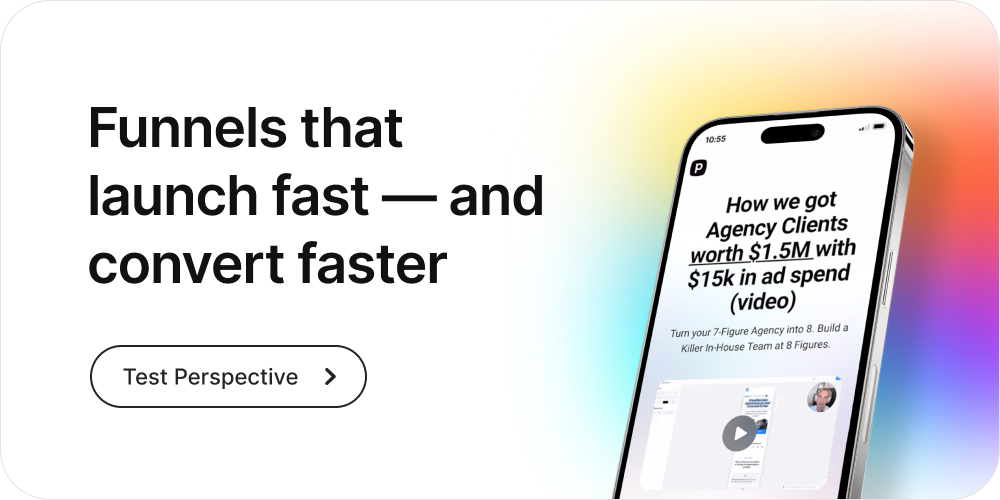


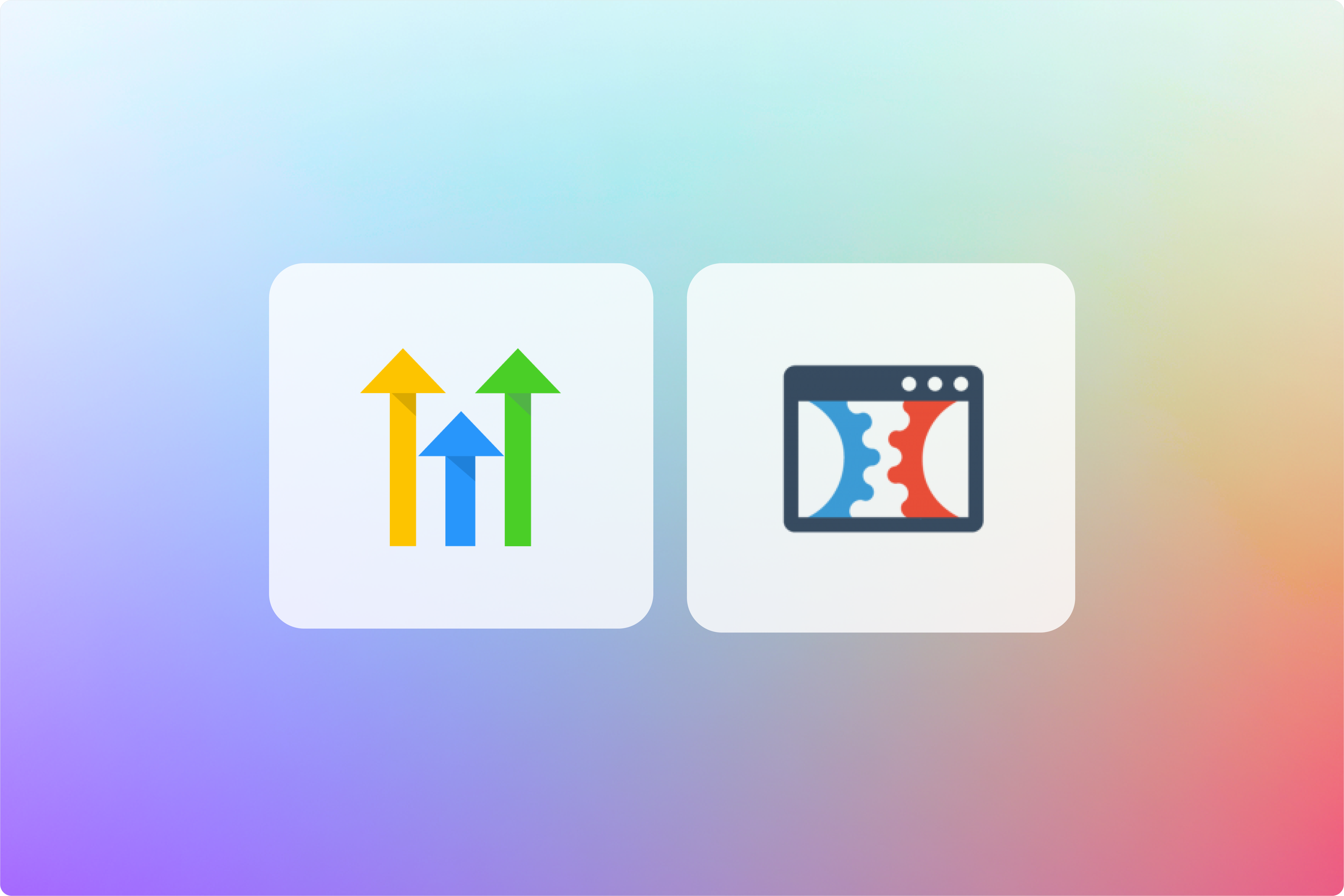
.png)




